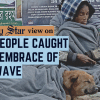Prepare hospitals for the high winter caseload

The winter has predictably brought a wave of suffering in the country, and it owes as much to the cold weather as to the lack of preparation and resources, making the poor and homeless suffer disproportionately. Over the last few days, we have come across reports highlighting the many winter-related effects, including shrinking income opportunities for those in the informal economy, lack of food, lack of protection against the cold, winter-related diseases, etc. Photos of people suffering without warm clothes and blankets have gone viral. As the mercury dropped, so has their hope of a quick relief.
Another effect that hasn't been talked about enough is the struggle of patients with cold-related diseases to get treatment at hospitals. Reportedly, the rising caseload has overwhelmed many hospitals, with bed crisis emerging as a big problem. There are too few beds for too many patients. For example, at the Khulna Medical College Hospital, which has 500 beds, there were 1,083 patients admitted as of Sunday, most of them forced to stay on the floors in wards, corridors and balconies. The accommodation problem was also reported at Tangail's 250-bed General Hospital, where the number of patients has increased almost four times.
Most of the patients crowding public hospitals, including children and elderly people, are suffering from pneumonia, asthma, diarrhoea, etc. There are also those suffering from burn injuries, which they sustained while sitting by the fire or using cooking stoves or after falling into boiling bathwater. The burn hospitals in Dhaka are overflowing with such patients coming from different parts of the country. Those with minor burns are also visiting the outdoor units. Of course, negligence and lack of awareness are mostly to blame for these burn injuries. But the fact that hospitals treating them as well as cold-related diseases are having such a difficult time to accommodate patients shows how a predictable surge in winter patients has turned into a logistical nightmare thanks to lack of preparation, for which the higher authorities must take responsibility.
The question is, why haven't they increased the capacity of hospitals to deal with the extra load? Unfortunately, lack of preparation and resources – not just medical – has hurt the most in regions known for poverty. As per a recent study covering the period of 2009-2021, an average of 104 people die annually in Bangladesh due to cold-related diseases and injuries, with the mortality rates higher in divisions with colder winter and higher poverty. Rangpur and Barishal are, unsurprisingly, the most at-risk divisions. What this shows is a direct link between poverty and winter suffering. And that the authorities have been slow to respond to the multidimensional threats of this combination has only made things worse.
Only the other day, we have commented on the lack of relief efforts from the government and affluent sections of society. But only relief will be of little help if we don't take note of the many-sided effects of winter. We, therefore, urge the authorities, including district administrations and public hospitals, to properly respond to poor people's need of food, warm clothes, income opportunity, medicine and treatment.

 For all latest news, follow The Daily Star's Google News channel.
For all latest news, follow The Daily Star's Google News channel. 





Comments